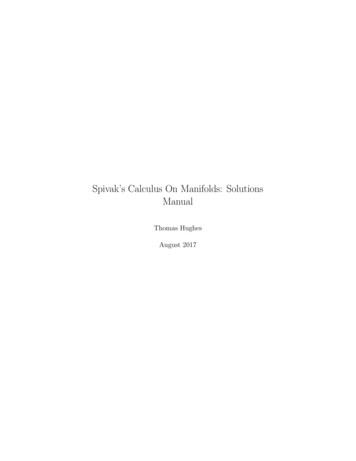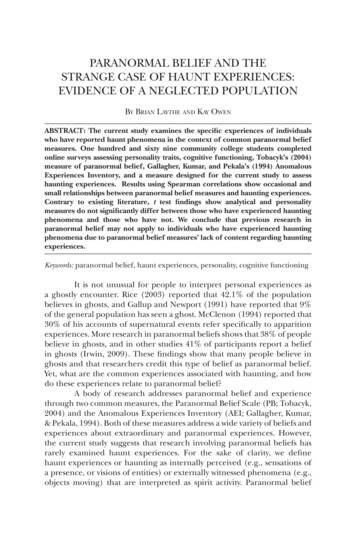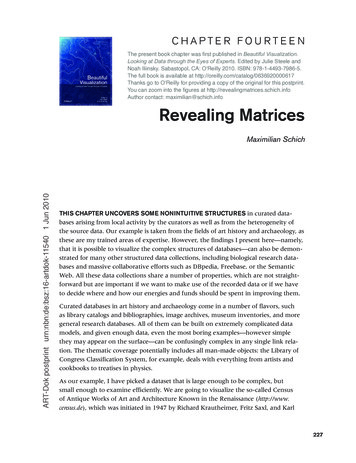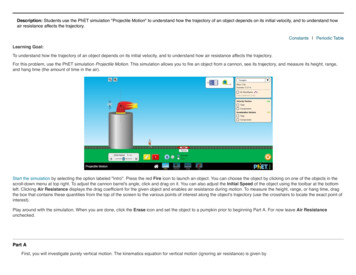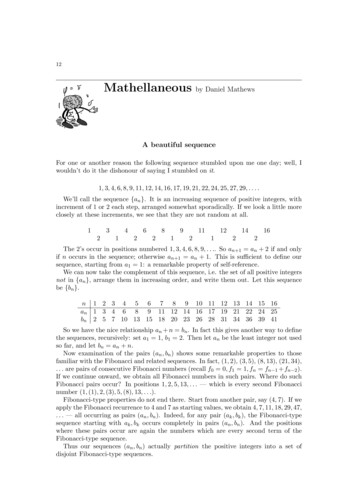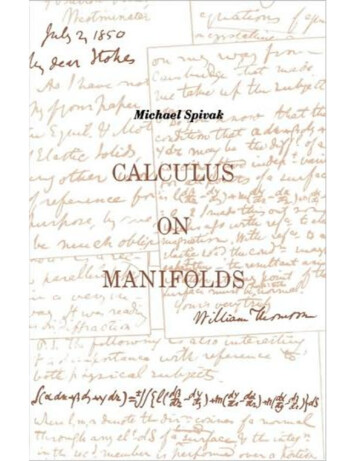
Transcription
Michael SpivakBrandeis UniversityCalculus on ManifoldsA MODERN APPROACH TO CLASSICAL THEOREMSOF ADVANCED CALCULUSADDISON-WESLEY PUBLISHING COMPANYThe Advanced Book ProgramReading, Massachusetts Menlo Park, California New YorkDon Mills, Ontario Wokingham, England Amsterdam BonnSydney Singapore Tokyo Madrid San Juan ParisSeoul Milan Mexico City Taipei
Calculus on ManifoldsA Modem Approach to Classical Theorems of Advanced CalculusCopyright 1965 by Addison-Wesley Publishing CompanyAll rights reservedLibrary of Congress Card Catalog Number 66-10910Manufactured in the United States of AmericaThe manuscript was put into production on April 21, 1965;this volume was published on October 26, 1965ISBN 0-8053-9021-924 25 26 27 28-CRW-9998979695Twenty-fourth printing, January 1995
Editors' ForewordMathematics has been expanding i n all directions at a fabulousrate during the past half century. New fields have emerged,the diffusion into other disciplines has proceeded apace, andour knowledge of the classical areas has grown ever more pro found . At the same time, one of the most striking trends inmodern mathematics is the constantly increasing interrelation ship between its various branches. Thus the present-daystudents of mathematics are faced with an immense mountainof material. In addition to the traditional areas of mathe matics as presented in the traditional manner-and thesepresentations do abound-there are the new and often en lightening ways of looking at these traditional areas, and alsothe vast new areas teeming with potentialities. Much of thisnew material is scattered indigestibly throughout the researchjournals, and frequently coherently organized only in theminds or unpublished notes of the working mathematicians.And students desperately need to learn more and more of thismaterial.This series of brief topical booklets has been conceived as apossible means to tackle and hopefully to alleviate some ofv
viEditors' Forewordthese pedagogical problems. They are being written by activeresearch mathematicians, who can look at the latest develop ments, who can use these developments to clarify and con dense the required material , who know what ideas to under score and what techniques to stress. We hope that they willalso serve to present to the able undergraduate an introductionto contemporary research and problems in mathematics, andthat they will be sufficiently informal that the personal tastesand attitudes of the leaders in modern mathematics will shinethrough clearly to the readers.The area of differential geometry is one in which recentdevelopments have effected great changes. That part ofdifferential geometry centered about Stokes' Theorem, some times called the fundamental theorem of multivariate calculus,is traditionally taught in advanced calculus courses (second orthird year) and is essential in engineering and physics as wellas in several current and important branches of mathematics.However, the teaching of this material has been relativelylittle affected by these modern developments ; so the mathe maticians must relearn the material in graduate school , andother scientists are frequently altogether deprived of it. Dr.Spivak's book should be a help to those who wish to seeStoke ' s Theorem as the modern working mathematician seesit. A student with a good course in calculus and linear algebrabehind him should find this book quite accessible.Robert GunningHugo RossiPrinceton, New JerseyWaltham, MassachusettsAugust 1965
PrefaceThis little book is especially concerned with those portions of"advanced calculus" in which the subtlety of the concepts andmethods makes rigor difficult to attain at an elementary level.The approach taken here uses elementary versions of modernmethods found i n sophisticated .mathematics. The formalprerequisites include only a term of linear algebra, a noddingacquaintance with the notation of set theory, and a respectablefirst-year calculus course (one which at least mentions theleast upper bound (sup) and greatest lower bound (inf) of aset of real numbers) . Beyond this a certain (perhaps latent)rapport with abstract mathematics will be found almostessential.The first half of the book covers that simple part of ad vanced calculus which generalizes elementary calculus tohigher dimensions. Chapter 1 contains preliminaries, andChapters 2 and 3 treat differentiation and integration.The remainder of the book is devoted to the study of curves,surfaces, and higher-dimensional analogues. Here the modernand classical treatments pursue quite different routes ; there are,of course, many points of contact, and a significant encountervii
VUlPrefaceoccurs in the last section. The very classical equation repro duced on the cover appears also as the last theorem of thebook. This theorem (Stokes' Theorem) has had a curioushistory and has undergone a striking metamorphosis.The first statement of the Theorem appears as a postscriptto a letter, dated July 2, 18.50, from Sir William Thomson(Lord Kelvin) to Stokes. It appeared publicly as question 8on the Smith's Prize Examination for 1854. This competitiveexamination, which was taken annually by the best mathe, matics students at Cambridge University, was set from 1849 to1882 by Professor Stokes; by the time of his death the resultwas known universally as Stokes' Theorem. At least threeproofs were given by his contemporaries: Thomson publishedone, another appeared in Thomson and Tait's Treatise onNatural Philosophy, and Maxwell provided another in Elec tricity and Magnetism [13]. Since this time the name ofStokes has been applied to much more general results, whichhave figured so prominently in the development of certainparts of mathematics that Stokes ' Theorem may be con sidered a case study in the value of generalization.In this book there are three forms of Stokes' Theorem.The version known to Stokes appears in the last section, alongwith its inseparable companions, Green ' s Theorem and theDivergence Theorem. These three theorems, the classicaltheorems of the subtitle, are derived quite easily from amodern Stokes ' Theorem which appears earlier in Chapter 5.What the classical theorems state for curves and surfaces, thistheorem states for the higher-dimensional analogues (mani folds) which are studied thoroughly in the first part of Chapter5. This study of manifolds, which could be justified solely onthe basis of their importance in modern mathematics, actuallyinvolves no more effort than a careful study of curves and sur faces alone would require.The reader probably suspects that the modern Stokes'Theorem is at least as difficult as the classical theoremsderived from it. On the contrary, it is a very simple con sequence of yet another version of Stokes ' Theorem; this veryabstract version is the final and main result of Chapter 4.
PrefaceixIt is entirely reasonable to suppose that the difficulties so faravoided must be hidden here. Yet the proof of this theoremis, in the mathematician's sense, an utter triviality-a straight forward computation. On the other hand, even the statementof this triviality cannot be understood without a horde ofdifficult definitions from Chapter 4. There are good reasonswhy the theorems should all be easy and the definitions hard.As the evolution of Stokes ' Theorem revealed, a single simpleprinciple can masquerade as several difficult results; the proofsof many theorems involve merely stripping away the disguise.The definitions, on the other hand, serve a twofold purpose:they are rigorous replacements for vague notions, andmachinery for elegant proofs. The first two sections ofChapter 4 define precisely, and prove the rules for manipulat ing, what are classically described as "expressions of the form"P dx Q dy R dz, or P dx dy Q dy dz R dz dx. Chains,defined in the third section, and partitions of unity (alreadyintroduced in Chapter 3) free our proofs from the necessity ofchopping manifolds up into small pieces; they reduce questionsabout manifolds, where everything seems hard , to questionsabout Euclidean space, where everything is easy.Concentrating the depth of a subject in the definitions isundeniably economical, but it is bound to produce somedifficulties for the student. I hope the reader will be encour aged to learn Chapter 4 thoroughly by the assurance that theresults will justify the effort: the classical theorems of the lastsection represent only a few, and by no means the most im portant, applications of Chapter 4; many others appear asproblems, and further developments will be found by exploringthe bibliography.The problems and the bibliography both deserve a fewwords. Problems appear after every section and are num bered (like the theorems) within chapters. I have starredthose problems whose results are used in the text, but thisprecaution should be unnecessary-the problems are the mostimportant part of the book, and the reader should at leastattempt them all. It was necessary to make the bibliographyeither very incomplete or unwieldy, since half the maj or
XPrefacebranches of mathematics could legitimately be recommendedas reasonable continuations of the material in the book. Ihave tried to make it incomplete but tempting.Many criticisms and suggestions were offered during thewriting of this book. I am particularly grateful to RichardPalais, Hugo Rossi, Robert Seeley, and Charles Stenard fortheir many helpful comments.I have used this printing as an opportunity to correct manymisprints and minor errors pointed out to me by indulgentreaders. In addition, the material following Theorem 3-1 1has been completely revised and corrected. Other importantchanges, which could not be incorporated in the text withoutex cessive alteration, are listed in the Addenda at the end of thebook.Michael SpivakWaltham, MassachusettsMarch 1968
ContentsEditors' Foreword, vPreface, vii1. Functions on Euclidean SpaceNORM AND INNER PRODUCT,1SUBSETS OF EUCLIDEAN SPACE,FUNCTIONS AND CONTINUITY,2.DifferentiationBASIC DEFINITIONS,BASIC THEOREMS,PARTIAL DERIVATIVES,DERIVATIVES,30INVERSE FUNCTIONS,IMPLICIT FUNCTIONS,NOTATION,445111515191253440 Xl
Contents xu3. IntegrationBASIC DEFINITIONS,4646MEASURE ZERO AND CONTENT ZERO,INTEGRABLE FUNCTIONS,'FUBINI S THEOREM,56PARTITIONS OF UNITY,QHANGJ J OF VARIABLE,525063674. Integration on Chains75ALGJ BRAIC PRELlMlNARms,FIELDS AND FORMS,7586GJWMETRIC PRF LIMINARIES,97THl FUNDAMI NTAL THEOREM OF CALCULUS,1095. Integration on ManifoldsMANIFOLDS,109FmLDS AND FORMS ON MANIFOLDS,'STOKES 'fHEORI M ON MANIFOLDS,THE VOLUME J LgMENT,126THE CLASSICAL THI ORI MS,Bibliography, 139Index, 14-1134100115122
Calculus on Manifolds
1Functions on Euclidean SpaceNO R M AND INNER PROD UCTEuclidean n-spaceRn is defined as the set of all n-tuplesn ) of real numbers .--ri ( a " 1 -tuple of numbers" isjust a number and R1 R, the set of all real numbers) . Anelement of Rn is often called a point in Rn, and R1, R2, R3 areoften called the line, the plane, and space, respectively. If xdenotes an element of Rn, then x is ann-tuple of numbers, the(x1, .--r,.ith one of which is denoted.T .--ri;thus we ran write(xi, . ,xn).A point in Rn is frequently also called a vector in Rn,because Rn, with ;r y (x1 y1,,xn yn) andax (ax\ . ,axn), as operations, is a vector space ( overthe real numbers, of dimension n ) . In this vector space thereis the notion of t he length of a vector x, usually called the . (xn) 2.!xi of x and defined by !xi V (x1) 2 If n 1 , then !xi is the usual absolute value of x. The rela tion between the norm and the vector space structure of Rn isnormvery important.·1··
Calculus on Manifolds21-1If x, y E Rn and a E R, then(1) lx! 0, and lx\ 0 if and only if x 0.(2) l i 1 x iy ij lxl · lyl; equality holds if and only if x and yare linearly dependent.(3) lx Yl lx l jyj .(4 ) !ax i Ia! · !x i .Theorem.Proof(1)is left to the reader.(2) If x and y are linearly dependent, equality clearly holds.If not, then A Y - x 0 for all A E R, so0 lAY - x! 2 ln(Ayi - x i) 2i-1A 2 l ( yi ) 2ni 1- 2 A l x iy i lnni- 1i 1(xi) 2.Therefore the right side is a quadratic equation in A with noreal solution, and its discriminant must be negative. Thus( l xiyi ) 2 - 4 l4(3)\x Yl 2nni 1i- 1lax! li 1(yi) 2 0.2;f 1 (xi yi ) 2 2; i (xi ) 2 2;i ( yi ) 2 2 2;i 1 xiyiby (2) lx \ 2 IYI 2 2\xl · IYI ( \x\ IY \ ) 2 -v2;f l (axi) 2 va 22;i 1 (xi ) 2 i a! · lx! . I 1(4)(xi) 2 .n1--------:.-:The quantity2;i 1 xiyi which appears in (2) isof x and y and denoted (x,y) .called theinner productThe mostimportant properties of the inner product are the following.1-2 Theorem.and a E R, then(1 ) (x ,y) ( y,x )If x , x 1 , x 2 and y, y 1 , Y 2 are vectors in(symmetry).Rn
3Functions on Euclidean Space(bilinearity) .(2) (ax,y) (x,ay) a(x ,y)(x 1 x 2 , y) (xt, y) (x 2 ,y)(x , Y1 Y 2) (x , y 1 ) (x ,y 2)(positive definiteness) .(x,x) 0, and (x,x ) 0 if andonly if x 0(4) !x! V(x, x) .(5) (x ,y) lx Yl' - lx - Yl'4(3)(polarization identity).Proof(1)(2)(x, y)By (1) i l y ixi it suffices to prove i l xiyi(ax, y)(x 1 x 2 , y) ( y ,x ) .a(x,y),(x 1 ,y) (x 2 ,y) .These follow from the equations(ax ,y)(x 1 x 2 , y ) nLi ln Li l (axi)yi anL xiyi a(x ,y),i l(x 1i x 2i) yi (x 1 ,y) (x 2 ,y) .nnl x 1 iy i L x 2 i Y ii li l(3) and (4) are left to the reader.(5)lx Y! 2 - lx - Y! 2 4by (4)·H(x y, x y ) - (x - y, x - y)]i[(x ,x) 2(x ,y) ( y,y) - ( (x,x) - 2(x ,y) ( y,y) )]( x , y) . IWe conclude this section with some important remarksabout notation. The vector (0, . . . ,0) will usually bedenoted simply 0. The usual basis of Rn is e 1 ,, en ,where ei (0, . . . ,1, . . . ,0) , with the 1 in the ith place.If T: Rn Rm is a linear transformation, the matrix of T withrespect to the usual bases of Rn and Rm is the m X n matrixA (aif) , where T(ei) j 1aiiei -th
Spivak's book should be a help to those who wish to see Stoke's Theorem as the modern working mathematician sees it. A student with a good course in calculus and linear algebra behind him should find this book quite accessible. Princeton, New Jersey Waltham,
